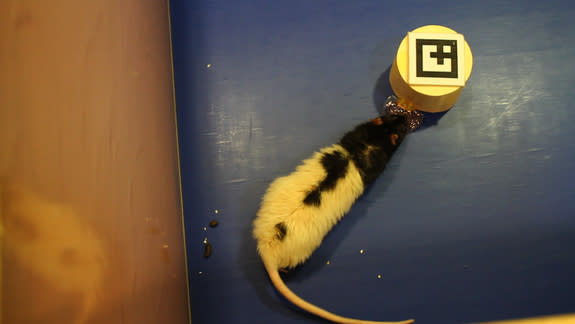Rats Control Human Avatars
Biologists are well-known for using lab rats in experiments, but a few may now have the chance to work with rats in a unique way.
A team of engineers has set up a system that lets lab rats control a human-shaped avatar in a virtual environment, while humans control a rat-size robot inside the rat's cage. The result? A six-foot human and a six-inch rat get to interact with each other remotely, and they get to each get to see either a virtual avatar or a robot that's close to their own size.
The research team created the setup mostly because it was a bit unexpected — "This particular implementation and experiment were mainly to show a highly novel application," one of the team's lead scientists, Mel Slater of the University of Barcelona and University College London, wrote to TechNewsDaily in an email — but it's also part of a larger effort to build a futuristic teleconferencing technology.
Slater and his colleagues are working on something they call "beaming," in which two people who are distant from one another control robots in each other's spaces. Usually, the team works on "beaming" humans to one another, not rats. [SEE ALSO: Hologram-Style Avatars Ready to Greet Airport Travelers]
This particular setup could also allow for some new experiments on rat and human behavior, said Mandayam Srinivasan, an engineer who splits his time between MIT and the University College London and who designed experiments with the new system.
Cooperating with a rat
During Srinivasan and his colleagues' experiments, study volunteers wore a helmet that showed them a virtual room with pictures hung in the middle of each wall. Volunteers could look around the room by turning their heads. They could walk in different directions by using a joystick held in one hand.
Meanwhile, in another lab several miles away, researchers had made a small, physical replica of the virtual room and put a lab rat in it. They also put a small, wheeled car in the rat's room. Whenever the study volunteer walked around in his or her virtual environment, the car would mimic the person's movements inside the rat's room. A smudge of jelly on the car enticed the rat to follow the car around.
Cameras mounted above the rat's little room tracked the animal's movement. Whenever the rat moved, the cameras would send a signal to computers that controlled an avatar the size and shape of a human inside a virtual room.
Researchers then told the study volunteers to try to lure the rat to stand under a particular picture to earn points. The researchers wanted to see whether rats could be trained to cooperate with humans using the new system.
It turned out they could. When the researchers tracked the movements of the two lab rats they used, they found the rats were more likely to venture into the middle of the room when a human-controlled car was there. Normally, rats prefer staying near walls and corners.
"It did show they were able to interact together," Srinivasan said. "It was possible to play this game with a rat."
Telepresence for the future
Other scientists could use this rat tele-presence system for their own experiments, Srinivasan said. He gave an example: "We can see how the behavior of the human is affected when they're told the other avatar they're seeing is controlled by a rat or a human."
In fact, Srinivasan and his colleagues tried this experiment themselves, running a trial in which they told study volunteers the avatar in the virtual room was controlled by a person, even though it was actually controlled by a rat. In that trial, people appeared to keep a polite distance from the avatar, which they didn't do when told it was rat-controlled.
Biologists could also personally control rat-size robots in experiments about rat behavior, Srinivasan said.
He and his colleagues have no further plans for developing the rat-human teleconferencing system, he said, but his colleagues at University College London and the University of Barcelona will continue to work on beaming. They're developing several beaming apps, including one for medical students to practice exams and another for people to learn to play a musical instrument.
When the technology is ready, they hope beaming will be a step up from the teleconferencing and tele-presence robots that are commercially available today, Srinivasan said.
"What it does that the current telepresence systems cannot do is actual, physical interaction between the remote human who is represented by a robot and the local human," Srinivasan said. "The robot could produce an object and you could touch that object. You could play a game with that robot."
Srinivasan and his colleagues published their work yesterday (Oct. 31) in the journal PLOS ONE.
This story was provided by TechNewsDaily, a sister site to LiveScience. Follow TechNewsDaily on Twitter @TechNewsDaily, or on Facebook.
Copyright 2012 LiveScience, a TechMediaNetwork company. All rights reserved. This material may not be published, broadcast, rewritten or redistributed.



